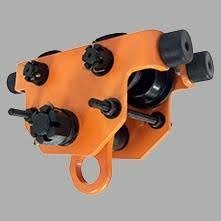The choice of I beam trolley is paramount in industrial environments in terms of efficient material handling and movement. Loading weight, compatibility of beams, and working environment are some variables that decision-makers should consider before taking up a model. With an assessment of load needs, dimensions, and trolley adjustments, facilities can maximize their workflow and avoid downtime. This guide provides key considerations to make trolley selection easy and performance predictable.
1.Assessing load capacity requirements
Responsible engineers should obtain the correct maximum load capacity before choosing an I beam trolley. The weight of the materials being lifted, with their fixtures, attachments, etc. is calculated to avoid overloading the trolley mechanisms. A critical safety margin should be added to take into consideration dynamic forces during lifting and travel. Peak loads and normal usage patterns are factors to be thoroughly assessed. Inadequate selection of trolley capacity may result in early wear, failures, and accidents. Proper capacity analysis prolongs the life of equipment.
2.Evaluating beam size and profile
The compatibility between the I beam trolley and the beam profile is crucial when operating. The beam width, flange thickness, and beam height are measured to make sure that the wheels are properly aligned with the beams. Checking and inspecting welding seams and straightness of beam prevents derailment and uneven wear. Adjustable trolleys will take care of minor variations, but beam accuracy will avoid large adjustments. When non-standard beams are involved, engineers are advised to check beam tolerances against trolley specifications and also take into consideration custom fittings to ensure safety and dependable performance.
3.Selecting wheel material and bearings
The type of material affects the noise level and durability of I beam trolley in operations. Steel wheels provide maximum strength and wear resistance on heavy loads, whereas nylon or polyurethane wheels minimize noise and guard beam surface when lighter loads are applied. Bearing type also influences rolling resistance and maintenance–sealed bearings require less attention, open bearings require easy inspection. Ensuring long term performance requires matching wheel hardness and bearing configuration to load characteristics and environmental conditions. Good lubrication and inspections maintain wheel integrity, reduce downtime, and improve reliability.
4.Adjustability and end stop options
Adjustable I beam trolleys feature flexibility in meeting evolving load locations and beam widths. Sliding side plates or adjustable wheel blocks enable accurate fitment to enable quick installation without modification of beams. End stops and bumpers are integrated into the trolley to avoid trolley overtravel and safe load positioning at the ends of the beam. The choice of the end stop styles (screw-in or welded stops) is based on the permanence of installation and the ease of adjustment. When the end stops are appropriately selected, the chances of collision and operational accidents are reduced. Adjustable characteristics provide versatility in various beam profiles.
5.Considering environmental and operational factors
Trolley choice is affected by environmental conditions like temperature, humidity, and chemical exposures. Rust-resistant finishes and sealed bearings are required in corrosive or wet applications to ensure performance. Protective wheel covers are useful in dusty or abrasive environments. Lubrication cycles and routine inspections depend on operational conditions such as travel speed and frequency. Low-profile trolleys are needed in confined or high spaces to maintain sufficient clearance. Tough trolley designs accommodate frequent starts, stops, and shock loading. Plants with long spans tend to use beam rollers to balance loads and prolong equipment life.
Conclusion
Facilities can select an I beam trolley that meets the requirements of their operation by considering the load capacity, compatibility with the beam, wheels available, and adjustability. Close attention to these issues reduces maintenance requirements, increases safety and extends equipment life. A proper specification review and frequent inspection make investing time in the specification worthwhile as the specified trolley would provide reasonable performance and enable effective material handling operations.







